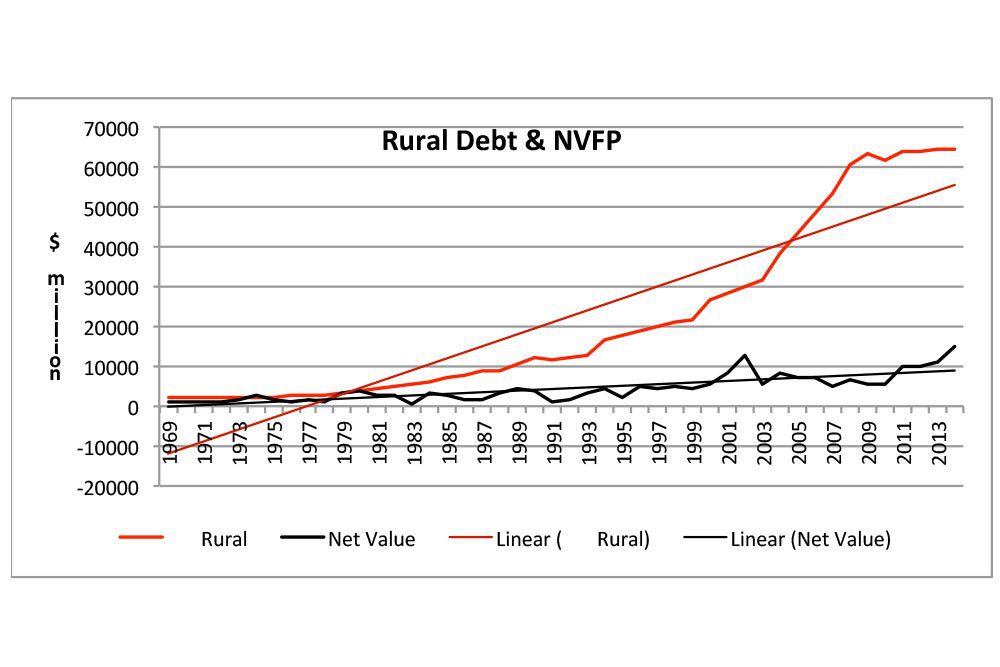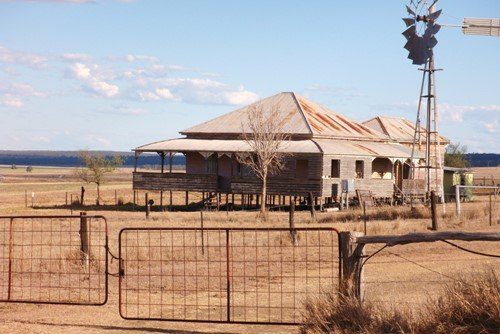Ben Rees is a farmer, a research economist and keynote and guest speaker at national and local rural meetings and conferences.
The story of rural Australia is encapsulated in the two curves below: debt, and net value farm production (NVFP). NVFP is an approximation of before tax farm income. Rural Australia is weighed down by unserviceable debt and low farm income:

*Compiled from ABARES commodity statistics, 2014, Table 13
The relationship between the two curves in the graph can only be explained by debt to equity lending without regard to capacity to repay. This problem was identified in a 1994 Senate Inquiry into Rural Adjustment, Rural Debt, and Rural Reconstruction. Successive Governments chose to ignore the 1994 Report and continued to support economies of scale policy commonly dubbed “get big or get out”. For three decades, governments relied upon debt to equity finance to underwrite “get big or get out” industry restructure. The GFC exposed the shallowness of political and economic thinking behind this policy.
The deregulation of the financial system allowed banks to move from originate and hold a mortgage system to the modern originating to distribute banking model. Under the new model, banks found their dependence upon deposits to build asset portfolios was reduced. Under Originate-to-Distribute banking, portfolio building in highly competitive market conditions did not need to be so particular about capacity to repay. Mortgage pools from which securities could be structured reduced deposit dependence. So long as asset inflation remained, the model was sound. The snag occurred with the GFC and subsequent toxic asset syndrome.
With onset of the GFC, government supported the urban housing market. Twenty-billion-dollars was allocated from which fourteen-billion-dollars was injected into the domestic residential-mortgage backed securities market. Government support did not extend to rural mortgage backed securities. When capital markets began looking at the quality of mortgage pools that underpinned securitization securities, rural asset pools were downgraded and devalued. Devaluation of mortgage pools flowed back to rural land values. Subsequently, Australian rural values fell 40% +. Anyone with debt to equity lending programs prior to the GFC were confronting questions of solvency. As banks moved to restructure asset portfolios, foreclosures began with impacts upon communities. The incidence of depression and rural suicides rose, accompanied by rural poverty.
Whilst different industries had their own particular catalyst, governments ignored the rural debt crises; preferring to build political camouflage through denial and drought aid policy. Conveniently, drought across Western Australia in 2012 and later in Queensland, and New South Wales offered the necessary political shield. At State and Commonwealth levels, the political strategy became drought-management policy rather than recognising the aftermath of the GFC and “toxic” rural assets.
Drought policy was never structured to address land value collapse. Risk-management theory underwrites drought policy. Risk-management theories expect farmers to walk around with mathematical models continually ticking over in their brain, calculating all production decisions. Those that do not have this internal mathematical genius are considered inefficient and slack farmers. With drought, farmers are expected to calculate accurately probabilities of occurrence and severity so they can prepare in advance. Drought-policy eligibility requires demonstrated long-term viability. Given the role of the GFC collapsing land values, this long-term viability requirement prevents many producers from accessing drought loans. Now drought costs are compounding eligibility requirements.
Those ineligible for drought loans receive support under household assistance, which provides food and other necessaries. But household assistance does not cover unexpected expenses such as medical or phone bills. Farmers then depend upon local and urban charities for emergency funds. Meanwhile, bank interest on debt continues so indebtedness compounds. Some 4,800 households are receiving household assistance. Implicitly, household assistance beneficiaries form a pool of potential bank foreclosures.
Rural policy is a mess. Debt restructure must be a first step in stabilising the sector. The lack of profitability must then be addressed. It will be surprising if speakers at the Sunday Mail Drought Forum will solve these policy issues in the hour provided.
Photographer: Alan Benge



